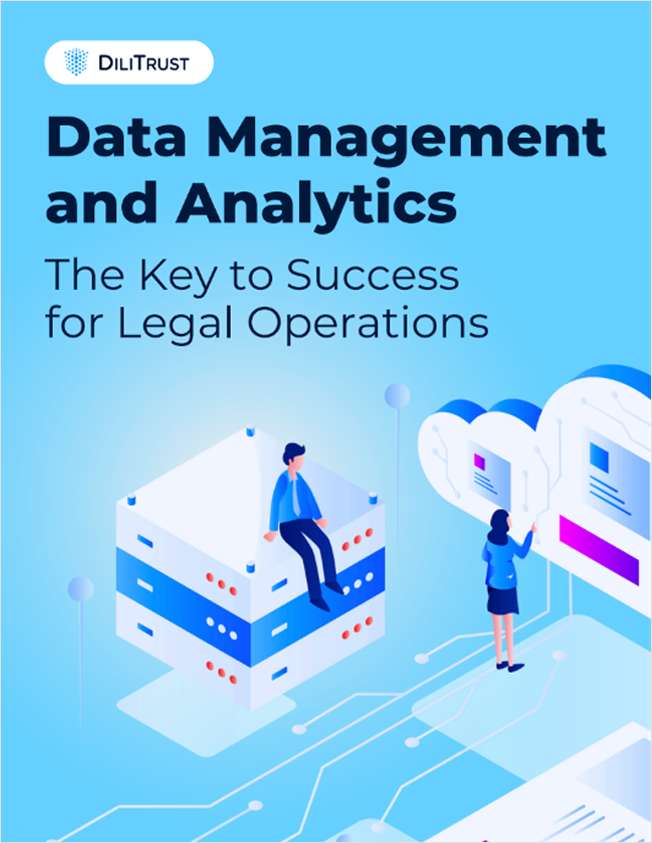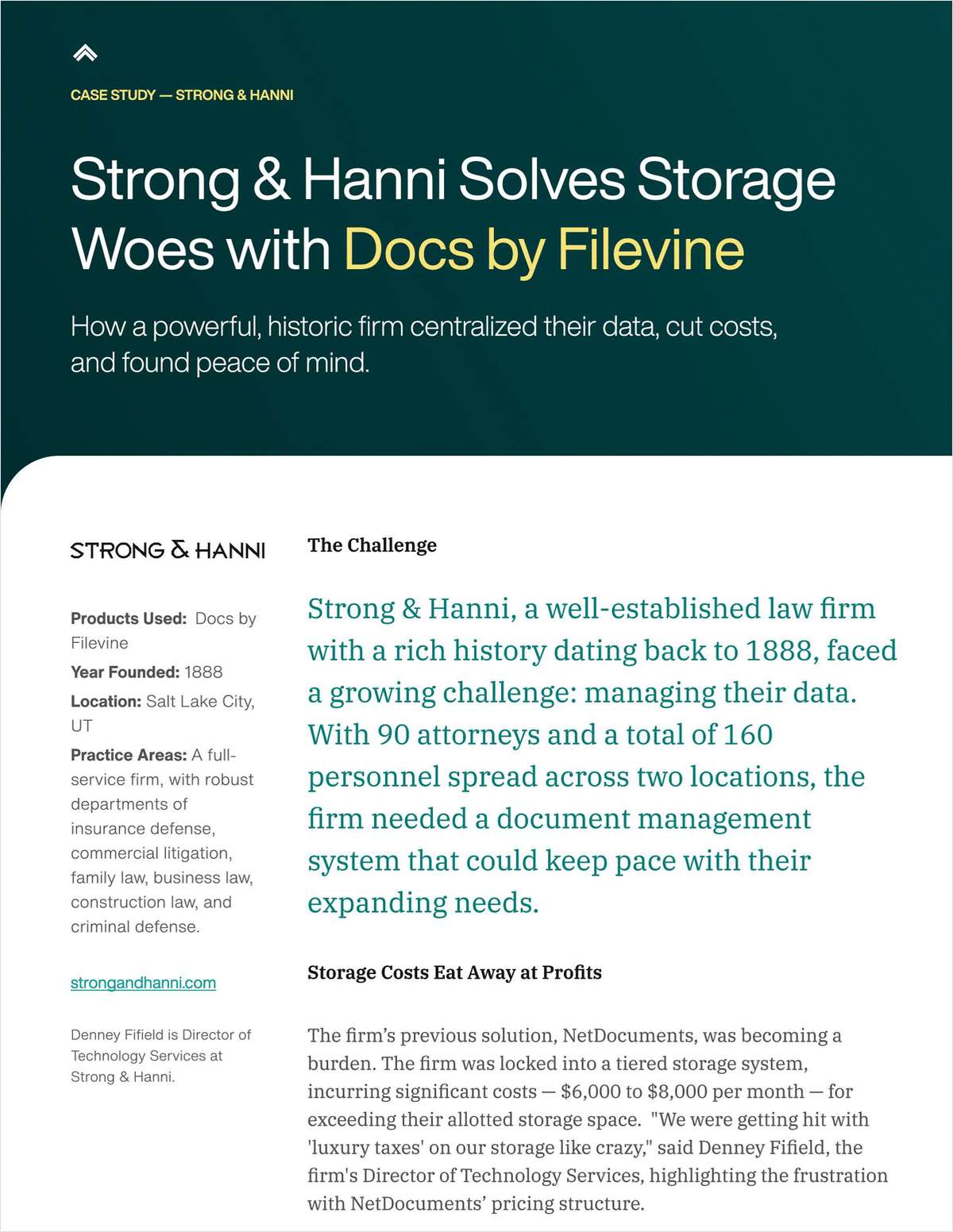AI Fears Subside: Most See Fundamental Change, but Not Job Loss
ILTA released a new Artificial Intelligence & Machine Learning report that alludes to fundamental changes coming for the legal industry—but those disruptions may not be happening where one would expect.
January 03, 2020 at 12:00 PM
4 minute read
The original version of this story was published on Legal Tech News

A new Artificial Intelligence & Machine Learning report published last week by the International Legal Technology Association (ILTA) indicates that while law firms may be expecting AI to yield "fundamental change" within the industry, lawyers shouldn't count on a significant portion of the work they perform being replaced by software.
When asked how long they believed it would be before AI-powered software would create "fundamental change" in the legal industry, the plurality of respondents (38%) to the ILTA survey said one to three years.
However, those changes may not equate to attorneys being able to drop entire items from their to-do lists all together. A separate question asked what the percentage of work (either legal or nonlegal) done by lawyers that respondents believed would be replaced by AI within the next five years. The majority of replies (55%) answered between 0-10%.
So where's the fundamental change happening? Beth Anne Stuebe, director of publications and press at ILTA, pointed to process and procedure-oriented business functions like budgeting as the areas where most of the work is changing as a result of AI and machine learning.
"I think it's talking about making the jobs more efficient and having a little bit better understanding maybe of the business problems the entire firm organization is trying to solve," Stuebe said.
But attempts to address those overarching business problems could actually wind up driving some fundamental changes of their own within the industry. For example, when asked whether legal departments should be leading law firms in the adoption of AI or vice versa, the majority of respondents (74%) indicated there should be a "mutual collaboration" between the two entities.
Stuebe believes this could open the door to law firms and legal departments working more closely together to address common problems down the line.
"I think everyone is trying to solve intrinsic business problems. Mutual collaboration only helps. We're not talking about privileged data here; we're talking about trying to solve business problems, and that's in the end essential to everyone's business," Stuebe said.
Other potential changes may be tied directly into the process by which organizations continue to refine their adoption of AI and machine learning tools. Per the survey, the the majority of respondents (80%) said a firm's chief information officer/IT director was the role typically involved in any AI-powered software purchase, development, training and deployment. Attorneys themselves followed closely behind at 62%—but innovation teams were a distant third with 42% of the vote.
Still, there's a chance that innovation teams could retake some ground as firms gain a better understanding how and why AI is being adopted under their roofs. For example, survey respondents identified contract analysis, discovery and investigation analysis, and legal research as the top three areas where AI-powered software would attain acceptable maturity first. Stuebe raised the possibility that e-discovery professionals and other legal technologists may develop their own processes and duties related to the deployment of AI.
"I think that's something we'll probably have answer to fairly shortly—I hope before the next decade," Stuebe said.
However, one thing that may not be changing any time soon is the relatively small number of law firms developing AI solutions from scratch, a demographic that represented only 10% of respondents. Purchasing out-of-the-box tools was the preferred way of procuring AI at 45%, following by customizing an out-of-the box tool at 32% and purchasing a platform and developing a tool within that platform at 13%.
This is a reality that may be dictated by limited resources more than attitudes toward AI. While bigger law firms may develop AI-tools customized toward specific tasks, there are still plenty of smaller entities that will keep outside software developers in business.
"Out-of-box tools are going to continue to, as we've seen, have great market share," Stuebe said.
ILTA declined to provide the number of respondents to its survey, but noted it was open to every member and partner within the organization, including attorneys and legal technologists from both the U.S. and international markets.
This content has been archived. It is available through our partners, LexisNexis® and Bloomberg Law.
To view this content, please continue to their sites.
Not a Lexis Subscriber?
Subscribe Now
Not a Bloomberg Law Subscriber?
Subscribe Now
NOT FOR REPRINT
© 2024 ALM Global, LLC, All Rights Reserved. Request academic re-use from www.copyright.com. All other uses, submit a request to [email protected]. For more information visit Asset & Logo Licensing.
You Might Like
View All
How Dana Rao Built a 'Yes' Culture at Adobe and Why He Walked Away

Keker Secures Defense Win for EDA Software Company Real Intent in Synopsys Copyright Infringement Case

Old Laws, New Tricks: Lawyers Using Patchwork of Creative Legal Theories to Target New Tech

Microsoft's Banner Year Pushed Brad Smith's Pay Sharply Higher
Trending Stories
- 1Infant Formula Judge Sanctions Kirkland's Jim Hurst: 'Overtly Crossed the Lines'
- 2Trump's Return to the White House: The Legal Industry Reacts
- 3Election 2024: Nationwide Judicial Races and Ballot Measures to Watch
- 4Climate Disputes, International Arbitration, and State Court Limitations for Global Issues
- 5Judicial Face-Off: Navigating the Ethical and Efficient Use of AI in Legal Practice [CLE Pending]
- 6How Much Does the Frequency of Retirement Withdrawals Matter?
Who Got The Work
Michael G. Bongiorno, Andrew Scott Dulberg and Elizabeth E. Driscoll from Wilmer Cutler Pickering Hale and Dorr have stepped in to represent Symbotic Inc., an A.I.-enabled technology platform that focuses on increasing supply chain efficiency, and other defendants in a pending shareholder derivative lawsuit. The case, filed Oct. 2 in Massachusetts District Court by the Brown Law Firm on behalf of Stephen Austen, accuses certain officers and directors of misleading investors in regard to Symbotic's potential for margin growth by failing to disclose that the company was not equipped to timely deploy its systems or manage expenses through project delays. The case, assigned to U.S. District Judge Nathaniel M. Gorton, is 1:24-cv-12522, Austen v. Cohen et al.
Who Got The Work
Edmund Polubinski and Marie Killmond of Davis Polk & Wardwell have entered appearances for data platform software development company MongoDB and other defendants in a pending shareholder derivative lawsuit. The action, filed Oct. 7 in New York Southern District Court by the Brown Law Firm, accuses the company's directors and/or officers of falsely expressing confidence in the company’s restructuring of its sales incentive plan and downplaying the severity of decreases in its upfront commitments. The case is 1:24-cv-07594, Roy v. Ittycheria et al.
Who Got The Work
Amy O. Bruchs and Kurt F. Ellison of Michael Best & Friedrich have entered appearances for Epic Systems Corp. in a pending employment discrimination lawsuit. The suit was filed Sept. 7 in Wisconsin Western District Court by Levine Eisberner LLC and Siri & Glimstad on behalf of a project manager who claims that he was wrongfully terminated after applying for a religious exemption to the defendant's COVID-19 vaccine mandate. The case, assigned to U.S. Magistrate Judge Anita Marie Boor, is 3:24-cv-00630, Secker, Nathan v. Epic Systems Corporation.
Who Got The Work
David X. Sullivan, Thomas J. Finn and Gregory A. Hall from McCarter & English have entered appearances for Sunrun Installation Services in a pending civil rights lawsuit. The complaint was filed Sept. 4 in Connecticut District Court by attorney Robert M. Berke on behalf of former employee George Edward Steins, who was arrested and charged with employing an unregistered home improvement salesperson. The complaint alleges that had Sunrun informed the Connecticut Department of Consumer Protection that the plaintiff's employment had ended in 2017 and that he no longer held Sunrun's home improvement contractor license, he would not have been hit with charges, which were dismissed in May 2024. The case, assigned to U.S. District Judge Jeffrey A. Meyer, is 3:24-cv-01423, Steins v. Sunrun, Inc. et al.
Who Got The Work
Greenberg Traurig shareholder Joshua L. Raskin has entered an appearance for boohoo.com UK Ltd. in a pending patent infringement lawsuit. The suit, filed Sept. 3 in Texas Eastern District Court by Rozier Hardt McDonough on behalf of Alto Dynamics, asserts five patents related to an online shopping platform. The case, assigned to U.S. District Judge Rodney Gilstrap, is 2:24-cv-00719, Alto Dynamics, LLC v. boohoo.com UK Limited.
Featured Firms
Law Offices of Gary Martin Hays & Associates, P.C.
(470) 294-1674
Law Offices of Mark E. Salomone
(857) 444-6468
Smith & Hassler
(713) 739-1250








